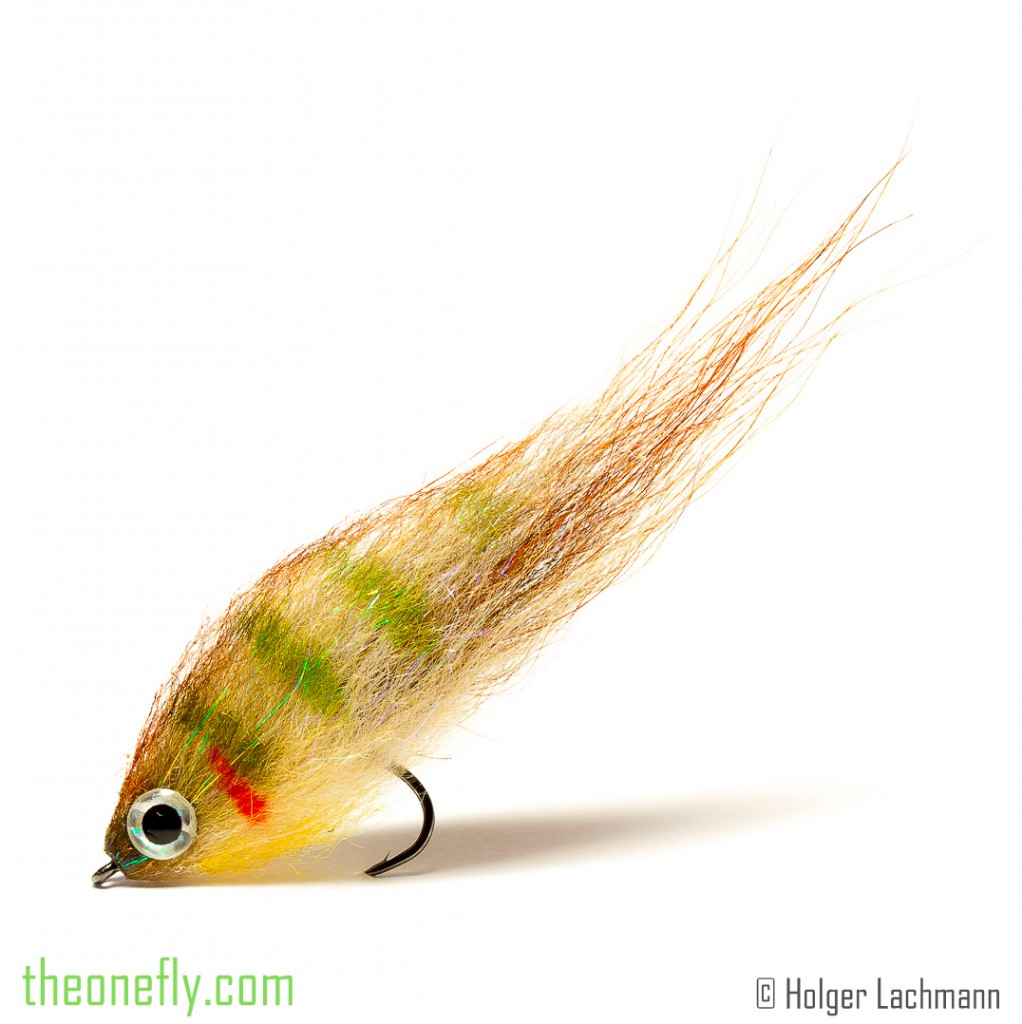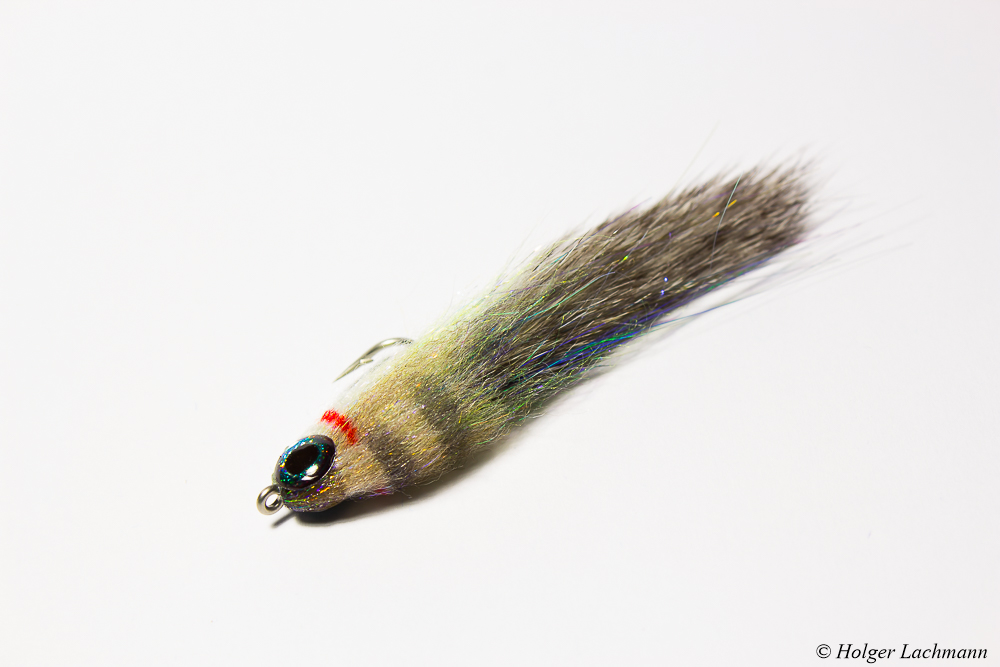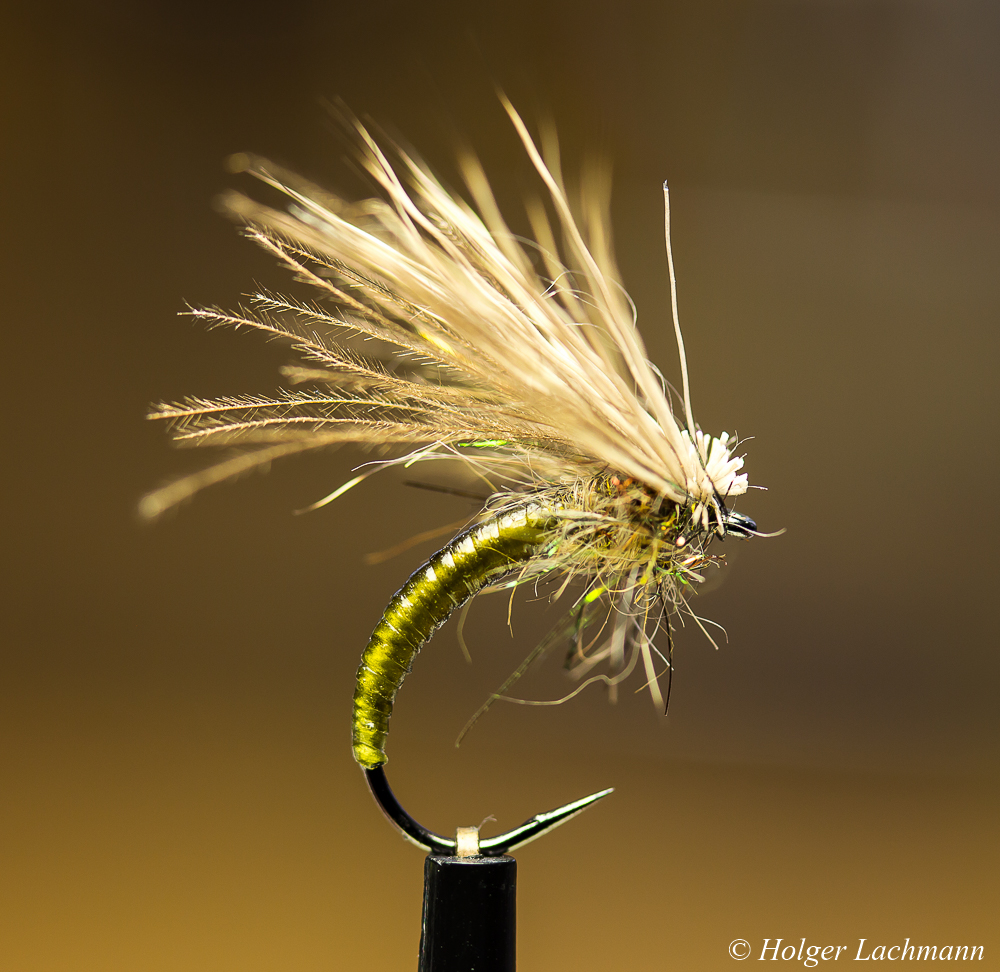Schlagwort-Archive: Hareline
THE BURNER „Saltwater Edition“
A Burner tied on a Tiemco 811s saltwater hook #2. You can find the step by step tutorial here: BURNER STEP BY STEP
Fuzzy Emerger
Tied on a Tiemco 212y #15, the nice segmented body made out of Stretch Flex is hanging in the surface. The dubbing, a mix of Hare’s Ear and Peacock Dubbing is imitating the legs and the CDC and Deer Hair makes this emerger float quite well. Just don’t put floatant on the body.
Good during mayfly hatches and works on a caddis hatch, too.
Last flies for 2014
Sculpins
Little sculpins #6 weighted with a tungsten head in the front. The deer hair head is secured with Bug Bond Lite to make it indestructible. I always liked this pattern und and I will always do, because I caught some really nice trouts with it. No matter, if you fish them upstream, in the swing or stripping them in, trouts love ‚em.
It takes a bit to cut the head and it’s always a mess on your tying table, but it’s worth it. At least for me it is. ;-)
Zonker Streamer
Three Zonker Streamer # 6. A hook, small Fish Skull, mono for ribbing, dubbing, zonker, some marabou and thread. You don’t need more for a good streamer with awesome movement in the water. You can fish it down and dirty where the big fish are and you don’t have to be afraid to loose your precious streamer, because you can tie some new – easy like 1-2-3….almost ;-) 
Stickleback Zonker – Fly Tying Tutorial
I made a new little video about an easy to tie pattern of a Stickleback.
[vimeo width=“600″ height=“500″]https://vimeo.com/108999238[/vimeo]
Seatrout Fly „Food“ Video Tutorial
I made last night a video tutorial of a seatrout pattern for the Baltic Sea. I just called it „Food“, because maybe the seatrouts think it’s a little fish or a shrimp….just food.
Unfortunately Vineo reduced the quality of the video. I’ll have to work on this.
Anyway, I hope you’ll like it. I think I will do some more videos in the future. Maybe you tell me, what you think about it.
[vimeo width=“600″ height=“500″]https://vimeo.com/108696581[/vimeo]
Caramel Shrimps
Caramel Shrimp Step By Step Video
This is the first time I made a video of the single steps to tie the fly. I hope you like it. The fly is a very good and looks even better in the water. Great pattern for Seatrout.
[vimeo width=“600″ height=“400″]http://vimeo.com/108574605[/vimeo]
UV Shrimps and Flatwing Tobis
Here is a spey shrimp tied with a little bit of uv materials. You can’t see them in normal light, jsut when you use your uv torch. Some say fish can’t see uv light, other say they have definitely more hook ups with flies tied with a bit of uv materials. I’ll let the fish decide… ;-)
Last but not least a Flatwing Tobis
Fly Tier’s Little Helper – Part 2 – Hackle Pliers
There are a lot of tools for the fly tier on the market. Some are good, some are useless, some are expensive but worth the money, some are cheap and still super usefull.
I used a lot of different tools and gimmicks in the last 20 years, and in this series I want to show things, which worked well for me and I’ll try to tell you why.
Part 2
Every fly tier needs a good hackle plier. You can find a lot of different pliers on the market. This are the two types I can highly recommend.
1. Dorin Hackle Plier
You can buy it normally for less than 5,- €. It works great and has a lot of power holding different materials. I use it often, when I have to tie with a high strength, especially ribbing with mono. Just wind the mono two times around the wire. The only negative point for me is, that my finger does not fit into the loop of wire.
This is the Dorin hackle pliers I use. It looks a bit shabby, but it’s over 13 years old.
From time to time the plastic tubing is damaged and the materials begin to slip. To solve the problem is very easy.
Just push the tube over the edge and cut it. Now it works like brand new. You can see, that it’s not necessary to do it often. Like I said, the one on the picture is more then 13 years old and it was used very often. There is still some tubing left. ;-)
Here is the expensive one. C&F hackle plier. About 30,- € for the cheapest model. Well, a lot of money, but it’s worth every cent. It works perfect as an all around hackle plier. You can tie with it many years and it still works like on day one. The rubber pads are missing on mine, but that’s no problem. Still working great.
The secret of success. The tip is rough in a microscopic way. Hackles, feathers and synthetics are hold very well.
This is the rotary version of the C&F, which I sometimes like to use when tying smaller patterns.
Well, that’s it! My two cent on hackle pliers. These are the pliers I use since many, many years without any problems. Still working perfect.
Fly Tier’s Little Helper – Part 1 – Bug Bond Pro Light Mains Adapter
There are a lot of tools for the fly tier on the market. Some are good, some are useless, some are expensive but worth the money, some are cheap and still super usefull.
I used a lot of different tools and gimmicks in the last 20 years, and in this series I want to show things, which worked well for me and I’ll try to tell you why.
I begin with something very special, the Bug Bond Pro Light Mains Adapter.
When you look at my flies, you’ll see that I work a lot with uv resin. No matter if I tie dries and nymphs or streamer and flies for pike, seatrout, asp, …
Working with uv resin means, you have to use a uv torch with maximun battery power to harden the resin. I often saw people using a torch with low power, wondering, why the resin won’t cure like it should.
Bug Bond offers a nice solution for the power problem: An adapter for your pro torch to connect it with your power supply at home. You just have to screw the adapter into the torch and you have a super strong uv torch every time.
To connect the adapter with the torch, you have to screw off the switch at the end.
Maybe you’re asking yourself how to switch on the torch without the switch at the end? With the Kit comes a solid foot switch like you know them from sewing machines. Just put your foot on the pedal and the torch will do it’s job.
The torch is always hanging from on of my lamps on my tying desk ready for some action.
I f you like to use uv resin for your tying, then I can recommend you the Mains Adapter. It’s super nice to use, you got always maximum curing power and you don’t have to care about the batteries.
I use the Adapter now several months and I don’t want to miss it.
5 new Burner
THE BURNER – A Step By Step Tutorial
This is a very durable and effective streamer pattern to imitate a small fish. It’s absolute versatile. Seatrout, trout, perch, asp, zander, … every fish which hunts for smaller fish is a good target for THE BURNER.
It looks good when dry, but it looks amazing when wet.
This is really a pattern which you should try.
Materials:
- Hook: Tiemco 811 S #4
- Weight: Lead Wire
- Ribbing: 0,25mm Mono
- Body: UV Ice Dub Olive Brown
- Back: Zonker Stripe
- Front: Different colors of Senyo’s Laser Dub
- Head: 3 D Eyes and Bug Bond Lite to secure it
Wind on the lead wire and attach the mono for the ribbing
Split the thread and put the Ice Dub between it. Spin the thread and brush the dubbing with your velcro, than wind the dubbing from the back to the front. Brush the body again with your velcro.
Tie in a piece of a zonker stripe and rib it with the mono. Catch the mono at the front with your thread.
Tie in some bunches of Senyo’s Laser Dub in the colors of your liking. The belly should always be brighter than the back. Finish with a whio finish behind the hook eye and comb the fibres back.
Take your super glue and put two 3D eyes on each side. Then take Bug Bond Lite UV Resin and put a drop between the eyes on the top and on the underside. The thin resin soaks into the head. Use your Bug Bond torch to harden the resin. If you like, you can do some gills behind the eyes with a thin marker pen.
That’s it! A sweet baitfish pattern with the great movement of the zonker stripe and the cool translucent look of the laser dub.
Tight lines and some good time at the water!









































